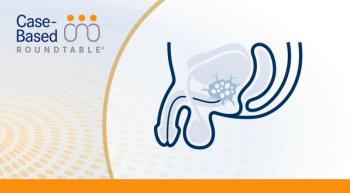
Part 3: Deciding on CRPC Therapy Based on Patient Case and Past Experience
Tanya Dorff, MD, asks the participants of a roundtable discussion which novel hormonal therapy they would choose in a patient with nonmetastatic castration-resistant prostate cancer.
CASE SUMMARY
A 57-year-old Black man presented with an elevated prostate-specific antigen (PSA) level. He had a history of seizures managed on medication and a family history of cancer (mother and sister had breast cancer and brother had pancreatic cancer). Bone scan was negative for metastases. He underwent a radical prostatectomy and extended lymph node dissection. Adjuvant radiotherapy was recommended but refused. Androgen deprivation therapy was initiated. After more than a year the patient re-presented with a PSA doubling time of 8.6 months and was still nonmetastatic.
A decision to add a novel hormonal agent was made. Which therapy would you most likely recommend?
DISCUSSION QUESTIONS
What factors influence your ultimate selection?
Does the patient’s history of seizures affect your choice?
How does darolutamide differ from other agents in its class?
Comment on toxicity and tolerability.
TANYA DORFF, MD: We have a pretty broad split. We have maybe a few more darolutamide [Nubeqa] fans. Anyone want to lobby for their choice—why they chose that drug? This patient has a seizure history. That’s an important factor to think about. Seizure history is relevant because, unlike enzalutamide [Xtandi] and apalutamide [Erleada], [darolutamide] doesn’t cross the blood-brain barrier, so it seems a reasonable choice.
VEENA CHARU, MD: I think darolutamide is a slightly better-tolerated drug overall.
ARATI CHAND, MD: I was told by the drug company that [darolutamide] doesn’t cross the blood-brain barrier, so the fatigue tends to be less compared with enzalutamide. So, patients tend to tolerate it a little better.
DORFF: Does that play out in your experience?
ALBERT DEKKER, MD: That may be hard to tell. We all have more patients who have fatigue on enzalutamide because we have used it for much longer than the darolutamide, which has not been around for as long.
DORFF: Does anyone have any apalutamide experiences?
CHAND: I have 1 patient on it, and he seems to be doing well. He’s been on it for 2 years now and I haven’t had any complaints.
DORFF: I think overall they’re well tolerated. I feel like more of my enzalutamide patients have adverse events [AEs] such that I have to either lower the doseor [discontinue the drug]. But I’ve seen AEs with all of the agents.
CASE SUMMARY
After shared decision-making, darolutamide was initiated.
DISCUSSION QUESTIONS
What are your thoughts on the choice of darolutamide?
What if the PSA doubling time were 15 months?
DORFF: Are you calculating doubling time? Do you only give [enzalutamide, apalutamide, or darolutamide] in nmCRPC for fast doubling times?
SANDY LIU, MD: I generally do, yes.
SARMEN SARKISSIAN, MD: Yes.
DORFF: What if someone’s doubling time is 10 or 11 months and they say, “I’m really nervous; treat my cancer.”
XINTING FU, MD: That’d be fine. I use 10 months as a cutoff. I give them the option.
DORFF: What about the trials in which the PSA had to be 2 ng/mL? I’ve had patients begging for a treatment when their PSA is 0.2 ng/mL, because they’re watching it rise even at those lower levels. Do you wait for a certain number or do you base it on doubling time?
FU: For 0.2 ng/mL, I would say no.
CHARU: I think if it were 0 or 0.1 ng/mL to begin with and it goes to 0.6 or 0.8 ng/mL within 6 months, then I’m more inclined to consider doing something.
FU: For such a low value, I don’t think there is harm to wait a little bit.
CHAND: That’s what I was going to say. Why not wait a little bit longer? Let the PSA rise. Because these medicines are not free of AEs. You have to consider risk and benefit of these drugs vs close observation.
CHARU: But some of the data show that if their PSA doubling time is 6 months, even if it’s not very high, there may be benefit to starting early. That was my understanding.
DORFF: I think it’s a challenge. Men who are really watching their PSAs and know that doubling time is important can push even before they get to integer numbers. “Why are you just watching my PSA double and doing nothing?” I find some of these discussions very challenging. But I hear your argument that these are not completely benign medicines. There are AEs and there’s cost. I tell them all those things.









































